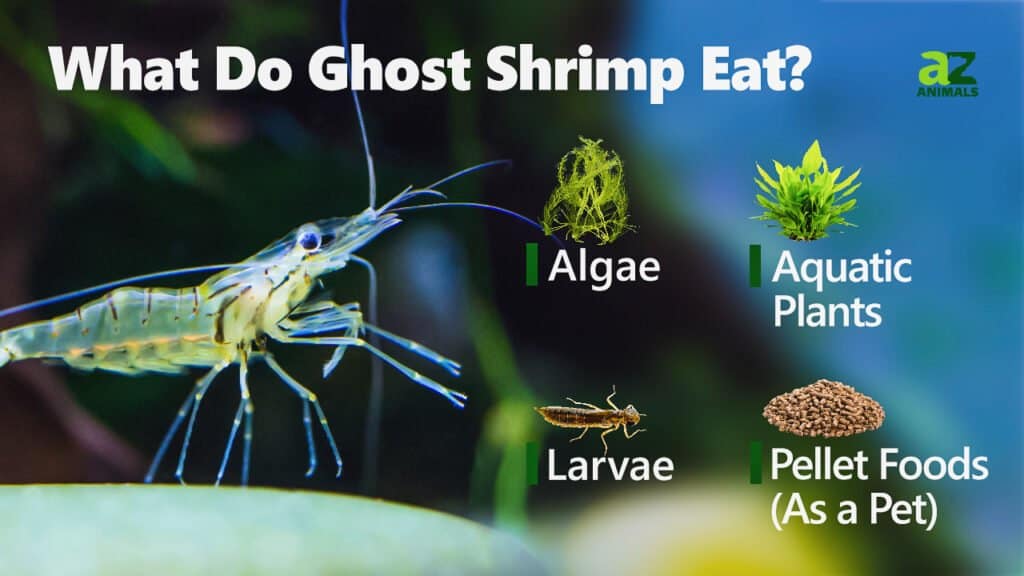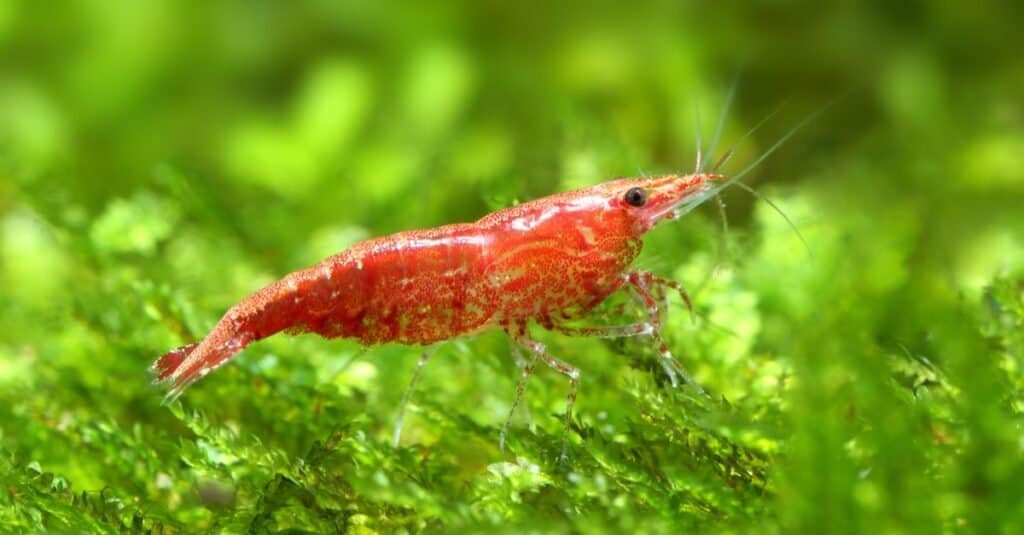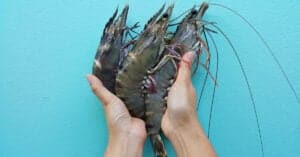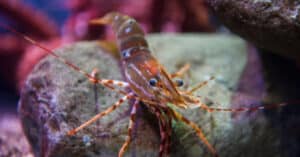Due to their popularity among aquarium owners and their incredibly unique appearance, the ghost shrimp generates a lot of curiosity. There is quite a bit to be curious about when it comes to an animal that is completely see-through! Many people are interested in how the ghost shrimp survives in the wild. This includes exactly what foods the ghost shrimp eats!
Ghost shrimp, glass shrimp, and grass shrimp are all common names for the three species of nearly transparent shrimp. This species of shrimp are found in freshwater ponds, lakes, streams, and rivers located in the coastal plains of Eastern North America. The crustaceans are highly popular aquarium animals, both as feeder species and as beginner pets for new aquarium owners. This is largely due to how easy and inexpensive they are to raise.
What Does The Ghost Shrimp Eat?

Like all shrimp species, the ghost shrimp is a true omnivore and can eat a wide variety of food. Ghost shrimp eat plant matter, insect larvae, and weeds. In captivity they can be fed pellet foods.
Shrimp are referred to as “bottom feeders” due to their habitat. This is also used to describe their ability to consume anything smaller than themselves. Of course, the specific diet of any species of shrimp is dependent on its environment.
There are also four species of crustaceans found in the Gulf of Mexico that are also called ghost shrimp. But while they share the same common name they are more closely related to crabs. As such, they have a different classification and are not one of the species of shrimp listed here.
What The Ghost Shrimp Eats In The Wild
All three species that are commonly known as ghost shrimp are found in freshwater locations. These are bodies of water like lakes, rivers, ponds, streams and creeks. Ghost shrimp are most found in locations with heavy amounts of underwater vegetation.
In the wild, the ghost shrimp’s main source of food is several types of diatoms and green algae. They also eat plant matter, insect larvae such as mayfly nymphs, and aquatic weeds. Additionally, the ghost shrimp will feed on any other organic matter that it finds at the bottom of the water. They will eat nearly anything, including dead aquatic animals or plants.
What Animals Compete With The Ghost Shrimp For Food?
Ghost shrimp encounter competition from smaller fish species that consume algae. They also compete with other bottom feeders like small freshwater crustaceans such as crayfish. They can consume anything smaller than themselves and a high adaptability to any source of food. So they usually don’t have trouble finding a meal!
What Animals Eat Ghost Shrimp in The Wild?
Ghost shrimp are a primary food source for any animal larger than themselves. They are a favored source of nutrition for many fish, primarily trout and largemouth bass. The species is also vulnerable to wading birds like ducks and geese. That is why they prefer to stay in areas with a high concentration of underwater grasses and stay deep underwater for most of the day, coming to the surface later in the evening.
Researchers also hypothesis that the transparency of the ghost shrimps body is an evolutionary adaptation that helps it to evade predators. Within the high concentration of underwater vegetation this species prefers to reside in, the ghost shrimp is almost undetectable!
How Does The Ghost Shrimp’s Diet Impact Other Species?
Like all species of shrimp, ghost shrimp act as cleaners, consuming a variety of dead and decaying matter that would otherwise build up and impact both the aquatic plants and the animals that live in them. Their consumption of anything at the bottom of their aquatic habitats allows for new growth and improves the overall health of their environment for the other species of animals that live alongside them.
Additionally, researchers are currently considering whether the ghost shrimp is a keystone species within its habitat. The keystone species within any environment is determined by the impact that species has on the overall wellbeing of other species and the environment itself. As ghost shrimp both act as the cleanup crew and a valuable food source for many other animals, it may be the key to the overall health of its environment.
What Do Pet Ghost Shrimp Eat?

Red Cherry Shrimp sitting on plants in an aquarium. Ghost shrimp are also used as feeder species in aquariums.
©topimages/Shutterstock.com
Ghost shrimp are a favorite aquarium species, both for their ability to help keep freshwater tanks free of algae, and as a feeder species for larger fish and aquarium pets. Many aquarium owners keep separate tanks for breeding ghost shrimp as a consistent source of pet food, as they are easy to care for and require little effort. This makes them a favorite for first-time fish owners!
Ghost shrimp can be fed anything given to other aquarium pets and will accept standard fish flakes and pellets. They will also consume any algae or fallen food found on the bottom or sides of the tank, as well as any dead vegetation from live plants. Additionally, ghost shrimp can be given boiled zucchini or soft vegetables as a method to provide additional nutrition if needed, though this may require the tank to be cleaned and maintained more often.
What Can’t You Feed A Pet Ghost Shrimp?
There is not much that the ghost shrimp cannot eat, but restrictions may include heavily processed foods that may contain preservatives if the shrimp are acting as a feeder species. Additionally, while ghost shrimp are a hardy species and consume algae, their health depends on regular tank cleaning. It is recommended that tank water be changed gradually, replacing sound 30 percent of tank water at one time to avoid causing the shrimp to go into shock.
What Aquarium Animals Eat The Ghost Shrimp?
Ghost shrimp can be used as a feeder species for a variety of freshwater tank fish, including Oscars, Trigger Fish, Arowanas, Angelfish Cichlids, and Discus. They are highly nutritious and are high in natural fats and oils that improve coloration and development for freshwater fish. Ghost shrimp are an economical choice as well, as they are one of the most inexpensive feeder shrimps commercially available!
The photo featured at the top of this post is © Alex Stemmers/Shutterstock.com
Thank you for reading! Have some feedback for us? Contact the AZ Animals editorial team.






